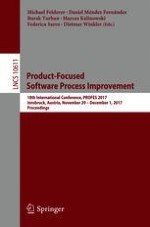2017 | Buch
Product-Focused Software Process Improvement
18th International Conference, PROFES 2017, Innsbruck, Austria, November 29–December 1, 2017, Proceedings
herausgegeben von: Dr. Michael Felderer, Daniel Méndez Fernández, Burak Turhan, Marcos Kalinowski, Federica Sarro, Dietmar Winkler
Verlag: Springer International Publishing
Buchreihe : Lecture Notes in Computer Science
